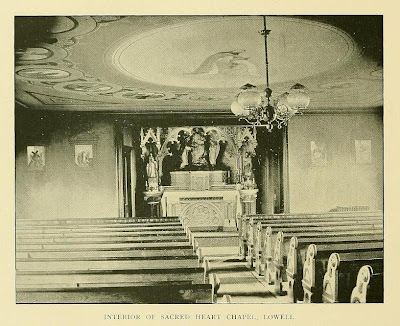DEVOUT WORSHIPPERS VISIT REPOSITORIES IN CHURCHES.
Commemoration of the Day of the Crucifixion and the Period of Darkness and Mourning—Catholic Notes Relating to Eastertide.
The Lowell Daily Sun
March 23, 1894
The repositories in the various Catholic churches of the city were visited by large crowds yesterday. The nuns of the various convents of the city visited each church, as did the pupils of St. Patrick’s convent and St. Peter’s Orphan Asylum.
The Sisters of Notre Dame arranged and attended to the respository in St. Patrick’s church. As in former years two school rooms adjoining the left transept of the church were were used, one being transformed into a beautiful sanctuary; the decorations were of white watered silk trimmed with gold fringe in festoons, and bunches of golden grapes. Tropical plants, palms and easter and calla lilies abounded, and nearly intermingled with them were numerous lighted candles making the scene one of great splendor.
At St. Peter’s church the repository was situated on the left side of the main altar. The decorations were of lace, with a profusion of lights and flowers.
The repository at the Immaculate Conception church was indeed beautifully arranged. St. Joseph’s altar was devoted to it, and the flowers which were without exception lilies, were very many in number. A number of palms added to the beautiful effect.
The Sacred Heart altar contained the repository at the church of the Sacred Heart, and was pleasingly arranged.
At St. Michael’s church the main altar was used as a repository and it is a perfect bank of flowers and potted plants. Hundreds of lighted candles illuminated the repository which was covered with gold and lace. During the day the church was visited by people from all sections of the city.
The repository at St. Joseph’s church is rich with gold and lace coverings. There were blazing tapers, potted plants, ferns and cut flowers tastefully arranged, and the whole is dotted with beautiful roses. The French people flocked to the church in hundreds during the day.
The crowd of visitors to St. Jean Baptiste church was fully as large as that at any other church during the day. The main altar is used as a repository, and is arranged on an elaborate scale. There are burning candles, potted plants, and bouquets, and gold altar coverings and lace hangings. Encircling all, and reaching high overhead, is a circle of vari-colored lights.
NOTE
The practice of visiting seven different Catholic churches on Holy Thursday is one that goes back to late imperial Rome, when Christians would visit seven Roman basilicas in order to gain spiritual benefits known as indulgences. In the pre-Vatican II era, this was a very popular practice in big cities, where there many parishes in close proximity to one another. New Yorkers, Philadelphians, Bostonians, Chicagoans, and many other urbanites of a certain age recall visiting seven churches during Holy Week.
Located some thirty miles northwest of Boston, Lowell is considered the birthplace of the Industrial Revolution in the United States. During the 1800’s, the small town grew into a major urban center, due mainly to immigration. The first of the parishes founded was St. Patrick’s, founded in 1831 to serve Irish immigrants coming to Lowell for work. Through the nineteenth century, these parishes served a mainly Irish and French Canadian population. Interestingly, four of the church buildings were designed by the renowned Catholic architect Patrick C. Keely (1816-1896): St. Patrick, Immaculate Conception, St. Michael and St. Peter.


















